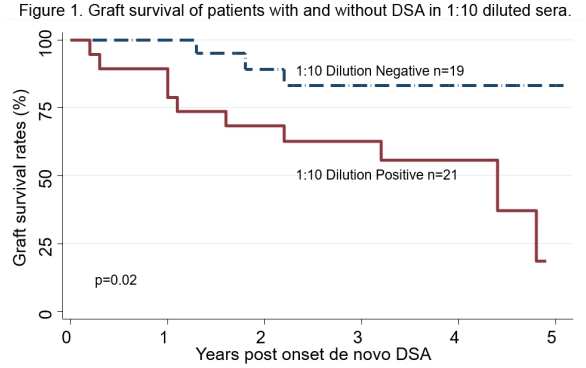The Value of Serum Dilution on DSA Outcome Analysis in Renal Transplantation
1Terasaki Research Institute, Los Angeles, CA
2East Carolina University, Greenville, NC
3Eastern Nephrology Associates, Greenville, NC
4Vidant Medical Center, Greenville, NC.
Meeting: 2018 American Transplant Congress
Abstract number: D89
Keywords: Graft survival, HLA antibodies, Kidney transplantation
Session Information
Session Name: Poster Session D: Kidney Complications: Late Graft Failure
Session Type: Poster Session
Date: Tuesday, June 5, 2018
Session Time: 6:00pm-7:00pm
 Presentation Time: 6:00pm-7:00pm
Presentation Time: 6:00pm-7:00pm
Location: Hall 4EF
Background: Recently, transplant centers have discussed the potential value of sera dilutions in assessment of donor specific anti-HLA antibodies (DSA). However, to date, no data exists assessing post-transplant outcomes and serum dilutions for DSA testing.
Methods: The study includes 40 patients from the East Carolina University who received a primary kidney transplant between 3/2008-1/2011. All 40 patients were class I or/and class II de novo DSA (dnDSA) by using 1:3 diluted sera. We tested serum for DSA at the time of dnDSA onset with class I and/or class II DSA by 1:10 dilution and compared this to the 1:3 testing results. Mean florescence intensity (MFI) > 1000 was defined as positive.
Results: All 40 patients were positive using a 1:3 sera dilution for DSA testing. Of the 40 patients who had dnDSA positivity on 1:3 diluted sera, 21 patients remained positive after testing their sera at a 1:10 dilution. There was not a difference in class of dnDSA that was negative on 1:10 testing. 40% (6/15) of patients with Class I dnDSA on 1:3 diluted sera were negative after the 1:10 dilution. For Class II dnDSA was 54%(15/28) were negative after the dilution. Survival analysis comparing the 1:10 dilution positive (n=21) versus 1:10 negative patients (n=19) indicated that the 1:10 dilution was strongly associated with transplant failure(Figure 1). Patients with DSA in 1:10 diluted (compared to those with 1:10 positive DSA) sera risk of graft loss within 5 years of DSA onset (HR 4.1 [1.1–14.9]).
Conclusions: In a group of kidney transplant patients with de novo DSA, using a 1:10 serum dilution yielded a stronger correlation with allograft outcomes. Further studies are needed to evaluate diluting sera, but serum dilution may be yet another tool to distinguish the riskiest de novo DSA.
CITATION INFORMATION: Huang W., Rebellato L., Briley K., Bolin P., Kendrick S., Maldonado A., Leeser D., Haisch C., Everly M. The Value of Serum Dilution on DSA Outcome Analysis in Renal Transplantation Am J Transplant. 2017;17 (suppl 3).
To cite this abstract in AMA style:
Huang W, Rebellato L, Briley K, Bolin P, Kendrick S, Maldonado A, Leeser D, Haisch C, Everly M. The Value of Serum Dilution on DSA Outcome Analysis in Renal Transplantation [abstract]. https://atcmeetingabstracts.com/abstract/the-value-of-serum-dilution-on-dsa-outcome-analysis-in-renal-transplantation/. Accessed December 24, 2025.« Back to 2018 American Transplant Congress

